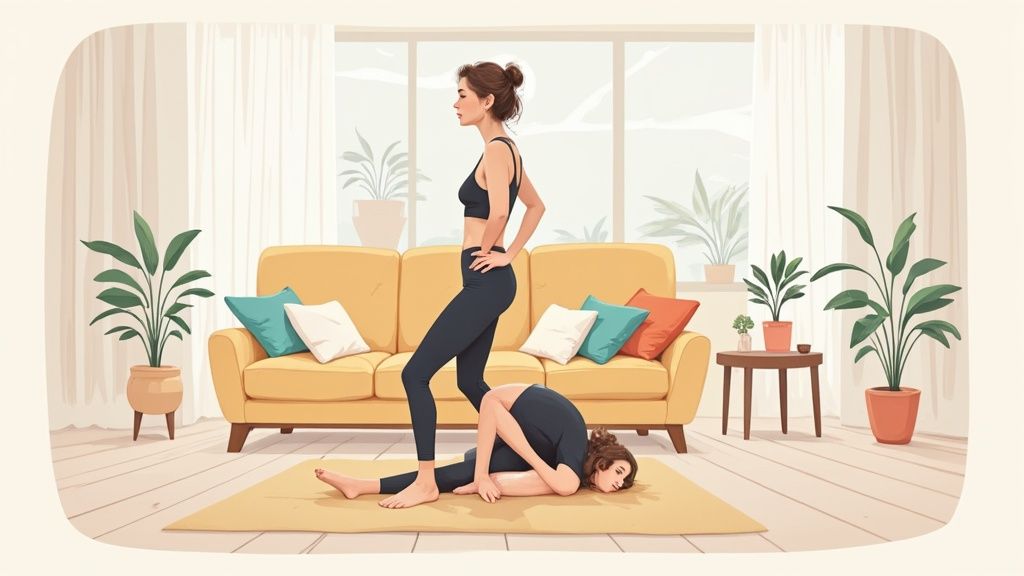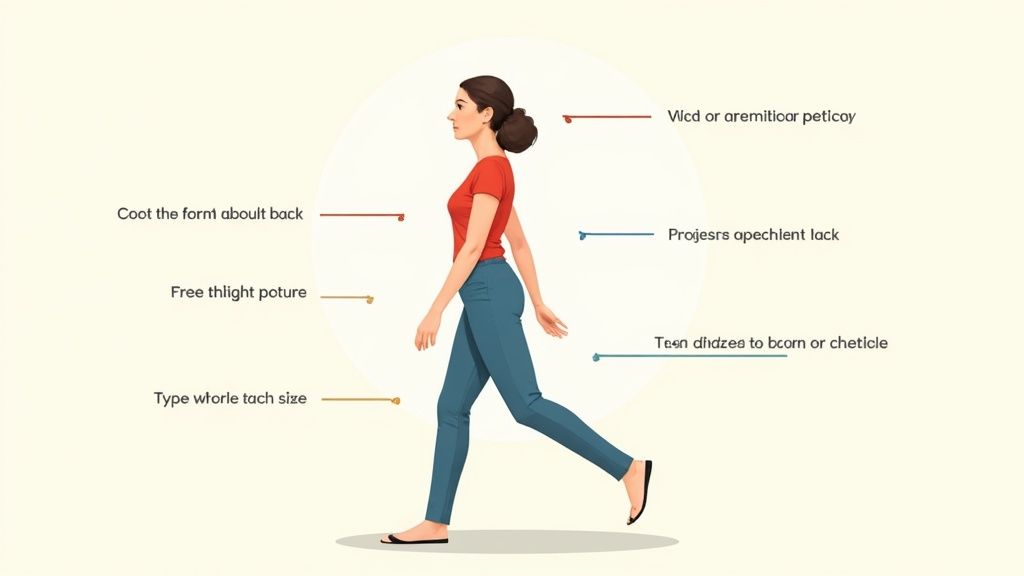How to Improve Posture: A Science-Backed Guide to Better Alignment
Understanding the Hidden Costs of Poor Posture

The way we hold our body has far-reaching effects beyond just how we look. Good posture plays a vital role in our overall health and daily function. Understanding how poor posture impacts our wellbeing is essential for making positive changes.
Beyond the Slouch: The Health Impacts of Poor Posture
Poor posture sets off a chain reaction in our body that can lead to ongoing health issues. Many people experience chronic back pain, neck strain, and frequent headaches from misaligned posture. The effects go deeper too - when we slouch, it compresses our internal organs and restricts proper breathing. Think of it like trying to fully inflate a balloon that's being squeezed - our lungs can't expand properly to take in enough oxygen when our posture is compromised.
The Domino Effect: How Posture Affects Energy and Mood
Bad posture does more than just cause physical discomfort. Research shows it directly impacts our energy levels because maintaining poor alignment requires extra muscle effort, leading to faster fatigue. Our posture also influences our emotional state in surprising ways. Studies have found that sitting and standing upright tends to boost confidence and self-esteem, while slouching can increase feelings of anxiety and low mood.
The Long-Term Risks: Preventing Future Health Problems
Ignoring poor posture now can create serious problems down the road. Over time, chronic slouching may lead to spinal issues like kyphosis, where the upper back develops an excessive outward curve. It can also cause joint pain and stiffness that limits mobility as we age. With the average American adult sitting for 6.5 hours daily, addressing posture habits early is crucial for preventing these long-term complications.
Identifying the Warning Signs: Listening to Your Body
To improve your posture, start by noticing how your body feels throughout the day. Pay attention to ongoing aches in your neck, back and shoulders. Watch for signs like regular headaches, feeling tired, or trouble taking deep breaths - these can all point to posture problems. While these symptoms may have other causes too, checking in with a healthcare provider can help identify postural issues early. Taking action when you notice these warning signs helps prevent further problems and supports better overall wellbeing.
Breaking the Modern Posture Trap
Poor posture has become a significant health challenge in our busy lives. Many of us spend long hours at desks, looking down at phones, and sitting in chairs that don't support proper alignment. This combination creates what I call the "modern posture trap" - a cycle of poor positioning that leads to neck strain, rounded shoulders, and back pain. The good news is that we can break free from these habits with some practical changes.
Ergonomic Adjustments: Rethinking Your Workspace
Making smart adjustments to your workspace is one of the most effective ways to improve posture. A good setup goes beyond just having a supportive chair - it's about creating an environment that promotes proper alignment throughout the day. Start by positioning your monitor at eye level to keep your neck straight. Place your keyboard where your elbows can rest at 90 degrees, which helps keep your wrists neutral. These simple changes can dramatically reduce physical strain and help you maintain better posture without constant effort.
The Power of Micro-Breaks: Movement as Medicine
Even with perfect ergonomics, staying in one position too long takes a toll on your body. Most Americans spend over 6 hours sitting each day, which can lead to tight, weak muscles. That's where micro-breaks come in - brief pauses every 30-60 minutes to stand up, stretch, or walk around can make a real difference. Think of these breaks as quick hits of movement that refresh both your body and mind. Just like snacking keeps your energy steady between meals, these movement breaks help maintain good posture throughout the day.
Posture Mindfulness: Training Your Awareness
Better posture also requires developing awareness of how you hold yourself. Rather than obsessing over every movement, focus on checking in with your body periodically throughout the day. Set simple reminders on your phone to notice if your shoulders are creeping up, if your head is jutting forward, or if your back is slumping. By gently correcting these patterns when you notice them, you can gradually retrain your natural alignment. This mindful approach helps create lasting postural improvements without feeling forced.
Integrating Technology: Apps for a Better Back
While screens and devices often contribute to poor posture, technology can also help solve the problem. Apps like Moova offer targeted movement breaks and exercises designed to counteract the effects of prolonged sitting. These quick 3-minute activity bursts fit easily into busy schedules and address common issues like stiffness and misalignment. By thoughtfully using technology along with workspace adjustments, regular movement, and increased body awareness, you can create lasting habits that support better posture and overall wellbeing.
Building Your Postural Foundation

With our workspace properly set up and movement patterns in check, let's focus on developing core strength - the foundation for good posture. Think of your core muscles like the support beams of a building - when they're strong and engaged properly, they keep everything stable and aligned. Building this foundation involves more than basic ab exercises - it requires understanding how to activate specific muscle groups that maintain proper posture throughout the day.
Targeting the Right Muscles for Postural Strength
While many people focus on visible ab muscles through exercises like crunches, good posture relies more on deeper core muscles. The transverse abdominis and multifidus act like an internal support system for your spine. Picture balancing a stack of books - without a solid base, they'll topple over. Similarly, these deeper core muscles prevent your spine from collapsing into poor alignment. By learning to engage these stabilizing muscles properly, you create a strong foundation for maintaining good posture naturally throughout the day.
Progressive Core Routines for Improved Posture
Building core strength works best with a step-by-step approach, starting with basic exercises and gradually increasing difficulty as you get stronger. Begin with foundational moves like planks and bird-dogs to develop stability and endurance. As you progress, add exercises like dead bugs and anti-rotation presses to further challenge your core stability.
| Exercise | Description |
|---|---|
| Plank | Hold a push-up position, forearms on the floor, body in a straight line from head to heels. |
| Bird-Dog | Start on all fours, extend one arm forward and the opposite leg back, maintaining a straight line. |
| Dead Bug | Lie on your back with knees bent and arms extended towards the ceiling. Lower one arm and the opposite leg towards the floor while maintaining core engagement. |
| Anti-Rotation Press | Kneel holding a resistance band anchored to the side. Extend your arms forward and resist the band's pull, keeping your core engaged and body stable. |
This gradual progression helps build lasting strength while minimizing injury risk, creating the foundation needed for long-term posture improvements.
Mastering Proper Form and Avoiding Common Mistakes
Using correct form during core exercises prevents injury and maximizes benefits. For instance, when doing a plank, keep your body in a straight line from head to heels - no sagging or arching. Many people unknowingly hold their breath during core work, which can strain the back. Instead, focus on steady breathing throughout each exercise. By paying attention to proper form and maintaining mindful movement, you'll target the right muscles to build a strong, supportive core. With consistent practice, you can see real posture improvements in just a few weeks, leading to both better alignment and increased comfort in your daily activities.
Leveraging Movement Practices for Better Alignment

While building core strength is essential for good posture, achieving proper alignment requires a well-rounded approach that includes movement practices focused on flexibility and body awareness. Regular practice of exercises like yoga, Pilates, and functional movement training can help develop the mind-body connection needed for lasting postural improvements. These practices work together to create better alignment through conscious movement.
Yoga: Cultivating Strength and Flexibility for Posture
Yoga offers an effective way to improve posture through its focus on mindful movement and breathing. Key poses like Warrior II, Triangle Pose, and Downward-Facing Dog help strengthen back muscles while opening the chest and lengthening the spine. For instance, practicing Warrior II builds leg and core strength while encouraging proper hip and chest alignment. This type of focused practice helps counteract poor postural habits from sitting. The mindfulness developed in yoga also makes you more aware of your posture throughout the day.
Pilates: Engaging the Deep Core for Spinal Stability
The Pilates method targets the deep core muscles that support proper spinal alignment. Foundational exercises like the Hundred, Roll-Up, and Teaser specifically strengthen often-overlooked stabilizing muscles. The Hundred, for example, activates the transverse abdominis muscle crucial for maintaining a neutral spine. This focused core work carries over into daily activities by providing better spinal support. The precise, controlled movements in Pilates also enhance your awareness of proper form and alignment.
Functional Movement: Improving Posture Through Real-World Movements
Functional movement training focuses on exercises that mirror everyday activities, making it especially relevant for improving posture. Basic movements like squats, lunges, and push-ups build strength in the muscles needed for daily tasks. This practical approach helps you maintain better alignment not just during exercise but throughout your regular activities. The balance and coordination work involved further develops your body awareness and control.
Breathing Techniques: Unlocking Postural Awareness and Releasing Tension
Breathing plays a key role in posture that often gets overlooked. Deep, diaphragmatic breathing engages core muscles while helping release tension in the neck and shoulders - areas commonly affected by poor posture. Simply practicing proper breathing while sitting at your desk can help prevent forward head posture. This type of mindful breathing increases oxygen flow and reduces muscle tension, creating better conditions for maintaining good posture. Making conscious breathing a daily habit significantly improves postural awareness and overall wellbeing.
The Body-Weight Connection
Your body's weight has a direct impact on your posture - much like a building needs a solid foundation to stay upright, your body requires proper weight balance for good alignment. Many people overlook this key relationship, but understanding it can make a major difference in improving your posture.
How Excess Weight Affects Posture
When you carry extra weight, particularly around your midsection, it shifts your body's center of gravity forward. This puts added strain on your lower back and can lead to poor posture since weakened abdominal muscles struggle to support your spine properly. Think about carrying a heavy backpack - the further away the weight is from your center, the harder your back muscles must work to compensate. Similarly, excess body weight pulls on your spine, causing your back to overarch and shoulders to round forward. Over time, this misalignment often leads to pain and makes maintaining good posture even more challenging.
The Impact of Weight Loss on Alignment
Losing weight, especially around the abdomen, can significantly improve your posture. As you reduce excess weight, there's less strain on your back, which allows your abdominal muscles to better support your spine. This helps restore your spine's natural curves and improves overall alignment. Research shows that reducing abdominal weight strengthens the core muscles essential for good posture. The benefits work both ways - better posture makes movement easier, which in turn supports continued weight loss efforts. This shows how closely connected your body weight and posture really are.
Targeted Exercises for Posture and Weight Management
Some exercises are particularly good at improving both posture and supporting healthy weight at the same time. These focus on strengthening your core muscles, which play a key role in stabilizing your spine and maintaining proper alignment:
- Plank: This exercise works your entire core, especially the transverse abdominis muscle that acts like a natural corset to support your spine and improve posture.
- Bird-Dog: This move targets your back muscles and core, helping with spine stability and balance.
- Squats and Lunges: These exercises build strength in your legs and glutes to improve your base of support and overall posture. They also burn calories effectively to help with weight management.
Realistic Approaches for Different Body Types
Everyone's body is unique, so there's no single approach that works for all. What helps one person may not work for another. For example, people with larger frames might need to modify certain exercises, while those with previous injuries may require different adaptations. Listen to your body, choose activities you enjoy, and gradually increase intensity as you build strength. Consistent effort over time leads to lasting results. Consider working with a healthcare provider or certified trainer to develop a plan tailored to your needs and goals. By focusing on core strength, maintaining a healthy weight, and doing targeted exercises regularly, you can create positive changes that enhance both your posture and overall health.
Creating Your Personalized Posture Blueprint

Ready to put all the posture building blocks into action? Just like constructing a house needs careful planning, improving your posture requires a clear strategy that combines core strength, flexibility, and daily habits into a routine that fits your life. Let's break down how to create a plan that works specifically for you.
Assessing Your Current Posture and Identifying Areas for Improvement
Start with an honest look at your current posture. Stand sideways in front of a mirror and check for common issues - are your shoulders rolling forward? Does your head stick out past your shoulders? Is there too much curve in your lower back? Take photos of yourself throughout the day while working, walking, and relaxing to spot patterns you might miss. These snapshots often reveal habits you didn't realize were affecting your posture.
Setting Realistic Goals and Creating a Step-by-Step Plan
Good posture develops gradually through consistent practice. Begin with simple goals you can achieve daily. For example, if you spend most workdays at a computer, start by taking a 2-minute movement break every hour. As this becomes natural, you can add more challenging exercises and longer practice sessions. Writing down your goals helps make them concrete and gives you clear steps to follow.
Incorporating Strength Training, Flexibility Exercises, and Daily Habits
Your posture plan should mix three key elements: exercises to build strength (especially in your core), stretches to improve flexibility, and regular posture checks throughout your day. Core exercises like planks build the foundation for good posture, while stretching tight muscles in your chest and hips helps maintain proper alignment. Set phone reminders to check your posture or do quick exercises - these small nudges make a big difference in forming good habits.
Tracking Your Progress and Staying Motivated
Keep tabs on your improvement to stay on track. Use a simple notebook or phone app to log your exercises and stretches. Note any changes in how your body feels, especially in problem areas like your neck, back, or shoulders. Even small wins deserve celebration - maybe your morning back pain is less intense, or you can sit comfortably for longer periods. These improvements show your hard work is paying off and encourage you to stick with your routine.
For a simple way to add movement to your day, check out Moova. This app provides quick 3-minute exercise breaks designed to improve posture and fight the effects of sitting. It's perfect for building healthy movement habits, even with a packed schedule.







